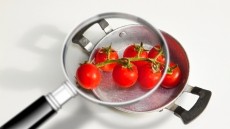Rot-resistant mutations and AI-fuelled robots – advancements in tomato cultivation

Tomatoes are often at risk from blossom-end rot (BER), but a new study has found that a mutation discovered in the 1950s, adpressa, actually makes these mutated tomatoes resistant to the rot without substantially negatively impacting their growth.
Another study found that large language model Chat-GPT-3 can help design robotic grippers to harvest tomatoes. It’s good for more than just answering emails.
Banishing blossom-end rot
The tomato mutation adpressa was discovered as early as the 1950s. However, it is only now that researchers, in a study published in the Journal of Experimental Botany, are discovering how its mutants are different from other tomatoes.
Adpressa means that tomatoes grow closer to the ground, as they cannot sense gravity. This is caused by a mutation in a gene that abolishes starch synthesis, which in turn causes major transcriptional and metabolic remodelling.
One of the major changes this provokes is the increase in soluble sugars during the fruit’s growth, as well as enhancing the growth itself.
Another major benefit of the mutation is that it makes the tomato completely resistant to BER. BER is a rot caused by lack of calcium in the fruit, rather than any interference by pests. It is usually indicated by greenish brown or black blotches at the end of the fruit where the flower was, furthest from the plant (the ‘blossom end’).
“Our findings with the adpressa mutant are quite promising,” said Phillipe Nicolas, one of the researchers.
“Contrary to what was previously thought, the lack of starch did not alter fruit development and ripening. In fact, adpressa fruits were slightly larger and accumulated more sugars during growth. The most remarkable discovery is the resistance to blossom-end rot. These findings open new avenues for improving fruit yield and quality, especially under stressful environmental conditions.”
Robot farmers
In a case study published in Nature Machine Intelligence, a group of engineers discuss how they used Chat-GPT-3 to design a working robotic tomato-harvester.
For the first phase, the researchers spoke to the large language model about the purpose of the robot, as well as its design parameters and specifications. This was called an ‘ideation.’
They spoke with the AI about concepts such as how to protect the future of humanity, and asked it to draw on its wealth of knowledge sourced from technical manuals, academic papers, books and the media to allow it to answer the question of ‘what features should a robot harvester have?’
In the second phase, Chat-GPT-3 generated code to fabricate the device and troubleshoot its functioning.
Once its initial form had been decided on, the researchers could ask it more specific questions, including what materials the grabber should be made from. Eventually, they narrowed it down to the specific code that it needed to run on.
There are some issues with using large language models to build things. For example, there’s a question of originality (did Chat-GPT-3 really believe tomatoes were the best fruit to cultivate, or is it simply mentioning that fruit that has been covered most extensively in literature?).
However, they were excited about the possibilities this presents for human-large language model collaborations in the future.
“Even though Chat-GPT is a language model and its code generation is text-based, it provided significant insights and intuition for physical design, and showed great potential as a sounding board to stimulate human creativity,” says Josie Hughes, one of the researchers.
Sourced From: Journal of Experimental Botany
'Starch deficiency in tomato causes transcriptional reprogramming that modulates fruit development, metabolism, and stress responses ’
Published on: 2 June 2023
DOI: https://doi.org/10.1093/jxb/erad212
Authors: P, Nicolas, R. J Pattison, Y, Zheng, T. Lapidot-Cohen, Y. Brotman, S. Osorio, A, R Fernie, Z, Fei, C. Catalá
Sourced From: Nature Machine Intelligence
'How can LLMs transform the robotic design process? ’
Published on: 7 June 2023
DOI: https://doi.org/10.1038/s42256-023-00669-7
Authors: F. Stella, C. D. Santina, J. Hughes















